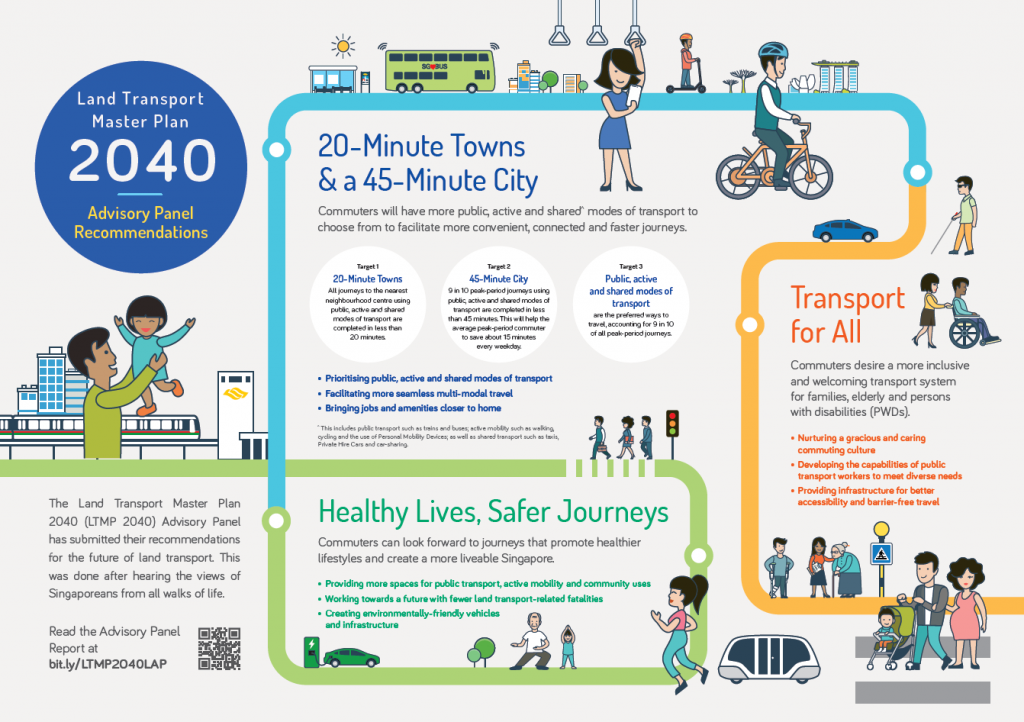The Land Transport Authority (LTA) released the Land Transport Master Plan (LTMP) 2040 report. This report encapsulates LTA’s long term plans to build a convenient, well-connected, inclusive and fast land transport system that will meet the needs and aspirations of Singaporeans over the next two decades and beyond.
The LTMP 2040 report contains detailed responses to recommendations made by the LTMP Advisory Panel (LAP) in February 2019 and accepted by the Government in March 2019. These recommendations were the product of extensive public consultations led by the LAP and facilitated by LTA officers (Annex B). Over 7,400 responses were received from commuters, transport workers, academia, industry partners, unions, students and interest groups over six months. Their ideas helped to shape the Panel’s nine recommendations, which were grouped under three key themes – A 45-minute City with 20-Minute Towns; Transport for All and Healthy Lives, Safer Journeys.
A 45-Minute City with 20-Minute Towns
To realise the goal of a 45-minute city with 20-minute towns, LTA will continue investing in public transport to make journeys more seamless and convenient. By 2040, new regional hubs outside the city will also bring jobs closer to homes, thereby shortening the average time taken to travel to work. We will also continue to expand the active mobility network to facilitate first-and-last mile journeys. Overall, commuters should have more time to live, work and play.
Improving Island-Wide Rail Connectivity
The LTMP 2040 report unveiled several key public transport enhancements. These include the expansion of the rail network, including several new stations and rail lines which will be developed over the next two decades.
Two new MRT stations will be opened on the North South Line (NSL) by the mid-2030s. Brickland Station will be added to the NSL. Located between Choa Chu Kang and Bukit Gombak stations, it will give residents in areas such as Keat Hong, Bukit Batok West, Pavillion Park and the Brickland district in Tengah town easier access to the rail network.
The NSL will also see the addition of a new Sungei Kadut interchange station connecting to the Downtown Line (DTL). This will be done by extending the DTL beyond Bukit Panjang station to serve the north-western region including Yew Tee, Choa Chu Kang, and the Sungei Kadut industrial area. The interchange station will serve upcoming developments at Sungei Kadut developed by JTC Corporation (JTC), such as TimMac for SMEs from the metal, machinery and timber industries; trendspace, Singapore’s first high-rise, multi-tenanted development housing both furniture and furniture-related companies; and the future Agri-Food Innovation Park (AFIP). Residents who live in the north-western region can look forward to faster commutes, with time savings of up to 30 minutes to the downtown area.
LTA will build the Thomson-East Coast Line (TEL) extension by around 2040 to provide a direct rail connection from Changi Airport to the city. It will also seamlessly link Changi Airport to stations along the TEL up to Woodlands North. We will announce more details when ready.
In addition, LTA will study the feasibility of a proposed rail line to serve new and growing developments in the north and northeast regions which may not currently have direct access to the rail network, such as parts of Woodlands, Sembawang, Sengkang and Serangoon North as well as areas such as Whampoa, Kallang and the Greater Southern Waterfront. This could relieve congestion along the northeast corridor and strengthen the overall resilience of the MRT network. More than 400,000 households could potentially benefit from this new line, with commuters saving up to 40 minutes when travelling to the city centre. LTA’s feasibility study will examine the demand, alignment, station locations and determine its implementation timeline.
Improving bus speeds and creating more seamless connections
To improve bus speeds, we will introduce more Transit Priority Corridors (TPCs) progressively. Areas under study include Robinson Road, Loyang, Tengah, Jurong Lake District and Woodlands North Coast. TPCs will have additional features beyond typical bus lanes. For example, LTA is exploring using smarter traffic light control system, bus-only roads and dedicated cycling paths alongside bus lanes to reduce travel times for both public transport and active mobility users along TPCs. The North-South Corridor, which will be completed in 2026, will be Singapore’s longest TPC, and will save bus passengers up to 15 minutes of travel time.
New Integrated Transport Hubs (ITHs) where bus interchanges are seamlessly integrated with malls, will be built. These include areas such as Beauty World, Bedok South, Hougang, Jurong East, Marina South, Pasir Ris, Tampines North and Tengah. ITHs give commuters convenient access to amenities as part of their public transport journey while also providing more seamless connections between buses and train. ITHs in Bidadari, Buangkok and Punggol North are already under construction.
Building on the 700km of cycling paths committed to by 2030, LTA will expand the cycling path network further to more than 1,000km by 2040. In new precincts such as Kampong Bugis, Tengah and Woodlands North Coast, LTA plans to build cycling paths on both sides of the road. New cycling paths may also be added in private residential estates and industrial estates.
Transport for All
Another key recommendation from the LTMP Advisory Panel is to ensure Singapore’s land transport system is inclusive. This means making our land transport accessible to all, and to foster a more caring and gracious commuting culture.
Making Land Transport Inclusive
To better serve those with mobility needs, LTA will gradually implement priority queues at all MRT stations, bus interchanges and ITHs for seniors, expectant mothers, wheelchair users and parents travelling with young children in strollers. The Public Transport Council (PTC) will also expand its Heart Zones initiative, which connects commuters who need help with volunteers, to all MRT stations and bus interchanges, where practical. LTA plans to pilot new ideas such as priority cabins on our trains for seniors, expectant mothers, wheelchair users, parents travelling with young children and other passengers who need a seat.
LTA will work with other government agencies to make journeys to public housing estates and public sector infrastructure barrier-free. For example, lifts have been installed at 47 pedestrian overhead bridges since 2013. 29 more pedestrian overhead bridges will be installed with lifts by 2022, including those near hospitals and polyclinics, with more to come.
LTA will improve the quality of the signage and announcements at all major public transport facilities, including signs with larger fonts and Braille. LTA will also be installing Next-Generation Passenger Information Displays (PIDS) on all buses by 2040. These panels will provide information on the next four stops along the bus route and the bus location relative to these as well as MRT and LRT transfer information. There will be on-board audio announcements of the next bus stop. The 50 diesel hybrid buses deployed from December 2018 are the first to have these PIDS. The 60 electric buses that will be deployed for service by 2020 will also come with the PIDS.
Healthy Lives and Safer Journeys
More Pleasant, Welcoming and Safe Streets
The LAP highlighted the role that the transport system can play in helping Singaporeans improve their health and well-being. As members of the inter-agency HealthySG Taskforce, which drives transformation efforts to promote healthy living in Singapore, MOT and LTA will design more pleasant, welcoming and safe streets to encourage walking, cycling and the use of public transport as healthier lifestyle choices. This is also part of our efforts to reduce the carbon footprint of our land transport system and contribute towards a more sustainable future.
To make our streets more conducive for walking, LTA will add at least 150km of covered linkways between MRT stations, residential areas and amenities by 2040. This comes on top of the 200km of covered link ways that were completed last year under LTA’s Walk2Ride programme. Bicycle parking facilities will be added at bus stops and MRT station exits to make it easier for people to cycle. By 2020, there will be 267,000 bicycle parking spaces, with more to be added by 2040. In future, we will dedicate more space to Walk-Cycle-Ride transport starting with 11 precincts including Kampong Bugis, Jurong Lake District and Woodlands Regional Centre.
To improve safety for vulnerable pedestrians, including the elderly, LTA will complete 50 Silver Zones, which comprise speed-limiting features such as narrower roads and speed humps, by 2023. A trial to lower speed limits further from the current 40km/h to 30km/h will be conducted at selected Silver Zones to make these areas even safer for the elderly.
Red-Amber-Green arrows will be installed at about 1,000 traffic junctions by 2023 and expanded to remaining junctions after 2030. Where it is not feasible to implement controlled right turns, we will install other safety features such as turning pockets, “Give Way to Pedestrian” signs and lit road studs to enhance the safety of motorists and pedestrians.
Cleaner Public Bus Fleets and Point-to-Point Fleets
To reduce the carbon footprint of public transport, LTA has committed to a 100% cleaner energy public bus fleet by 2040, comprising alternatives like electric or hybrid vehicles. LTA has already awarded a tender for the 60 electric buses which will be progressively delivered from end-2019 and deployed for service by 2020. In addition, LTA has deployed 50 low-emission diesel hybrid buses since the end of 2018. LTA will assess their performance under Singapore’s operating conditions and their cost effectiveness, and may buy more of such buses if the trials prove successful.
We are also heartened that industry players have stepped forward to play their role in improving our transport landscape as part of LTMP 2040. All taxi companies in Singapore have committed to having 100% cleaner vehicles by 2040. HDT Singapore Taxi Pte Ltd is already operating a fleet of fully electric taxis and aims to expand its fleet size to at least 800 by 2021. Some private hire car booking providers and car rental companies are doing the same and have committed to making their entire fleet run on cleaner energy by 2040. Companies such as Grab have also introduced electric vehicles in their existing fleets. Collectively, these efforts will significantly improve air quality and noise pollution in Singapore.
Bringing Singapore Together
The initiatives highlighted are among a suite of measures detailed in the LTMP 2040 report to effect the recommendations and strategies from the LTMP Advisory Panel. For more information on the other measures, visit LTA website.
The LTMP 2040 report has set out aspirational targets and the measures LTA plans to implement over the next 20 years to achieve these. LTA will continue to converse and work hand in hand with all stakeholders including the industry, community and other government agencies, to explore new avenues for collaboration to build a land transport system that all Singaporeans can be proud of for generations to come.










